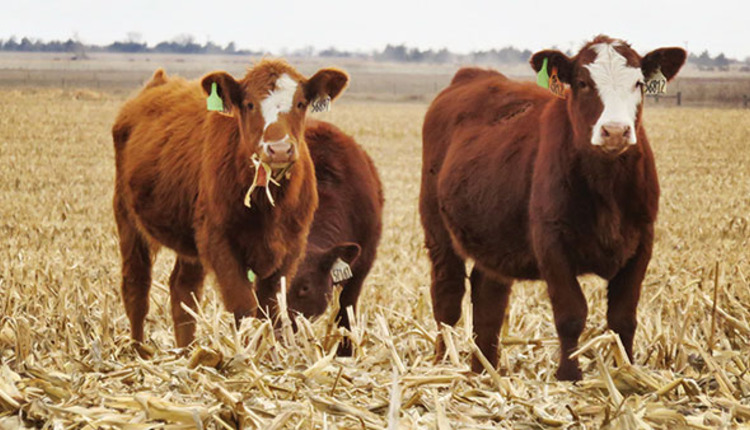Do corn genetics matter when grazing residue? |
| By Mary Drewnoski |
|
|
The author is a beef systems specialist, University of Nebraska.  Grazing cornstalks from modern hybrids often means less corn grain but more plant residue than in past years. Every year I hear cattle producers make the comment: “Cattle don’t seem to do as well as they used to when grazing corn residue.” Many of them go on to suggest it is due to genetic modification of the corn plant. When grazing corn residue, cattle select dropped corn grain along with the husks and leaves. The digestibility of the plant has not been found to differ between transgenic and the nontransgenic parent. The gain of calves, if supplemented with distillers or corn gluten feed, grazing transgenic versus the parental hybrid has not differed. In fact, the numerical differences in gain track better with the amount of dropped corn in the field than with genetic modification. So . . . has genetic modification caused the residue to be less nutritious? No and yes. The digestibility of the plant parts themselves has not changed due to genetic modification. However, there is now less ear drop than in the past because of transgenic traits, advancements in harvest technologies, and improved hybrid genetics. This means that the nutritive value of the residue in the field is likely lower because less total pounds of downed ears are available. Residue is still a good value Remember, the corn grain itself has more energy (83 percent total digestible nutrients [TDN]) and protein (10 percent crude protein) than any other plant part. In grazing studies conducted in the late 1980s and early ‘90s, grain remaining in the fields ranged from 2 to 14 bushels per acre. In similar studies conducted after 2000, corn remaining in the field ranged from 0 to 3 bushels per acre. At the same time, the yield of corn and the corresponding amount of residue has been rising; this has allowed cattle to graze on the same fields longer, consuming diets with an even greater proportion of husk and leaf relative to grain. Even with less available corn grain, mature, spring-calving cows that are in good condition can maintain body condition score (BSC) and have good rebreeding rates with no supplemental energy or protein if stocked at the appropriate rate. In a five-year study, supplementation of a distillers-based cube at 2.2 pounds per cow for animals grazing corn residue did not improve pregnancy rates or weaning weights over nonsupplemented cows. At the start of the winter, the cows had a good BCS of 5, and nonsupplemented cows were able to maintain BCS over the winter when grazing residue alone. However, if mature gestating cows are thin (BCS 4), they will respond to protein supplementation. Typically, we suggest feeding 0.3 pound of protein. This would be 1 pound of dry distillers or 2 pounds of modified distillers. Corn residue can also cost effectively be used to develop replacement heifers. Supplementation of 2 pounds of dry distillers to 600-pound heifers will typically result in an average daily gain (ADG) of 1 pound, while 4 pounds of dry distillers results in 1.5 pounds ADG. First-calf heifers have the greatest nutrient requirements in the cow herd. Corn residue can still be successfully grazed with first-calf heifers, but they do require supplementation. First-calf heifers in midgestation (six to three months prior to calving) will need protein supplementation at about 0.5 pound of protein per day. Supplementing about 1.8 pounds of dry distillers will correct this deficiency. During late gestation (three months prior to calving), first-calf heifers are both deficient in protein and energy. Feeding 3.3 pounds of dry distillers will meet their needs. Consider stocking rate Stocking rate affects the plane of nutrition. Digestibility (energy) of the diet is quite high at the initiation of grazing but declines with time because cattle select the more digestible parts such as the grain and husks early in the grazing period. Husks are about 60 percent TDN, and leaves are about 50 percent TDN. Cattle consume the cobs and upper stalks, which are only 35 percent TDN, when the availability of husks and leaves become limiting. Stocking rate recommendations dictate that corn residue can be stocked at one 1,200-pound cow for one month for every 100 bushels of corn. At this stocking rate, cattle would be consuming half of the leaves and husks available, which is only 15 percent of the corn residue produced. If grazed beyond this, supplementation of mature cows in late gestation is likely needed to meet energy and protein requirements. The plane of nutrition when cows were grazing corn residue 30 years ago is likely different than today because the amount of corn grain left in the field is often less than in the past. However, today corn residue is still one of the lowest cost resources for wintering cows in the Corn Belt, and mature cows can be wintered without supplementation if the appropriate stocking rate is utilized. This article appeared in the February 2017 issue of Hay & Forage Grower on page 8. Not a subscriber? Click to get the print magazine. |
